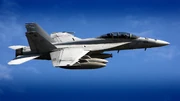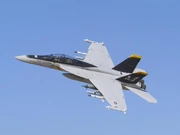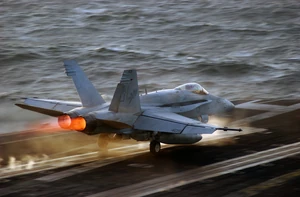| Boeing F/A-18 E/F Super Hornet | ||
|---|---|---|
| Description | ||
| Role | Fighter/Attack | |
| Crew | E: 1 pilot, F; student and instructor | |
| Passengers | 0 | |
| First flight | 29 November 1995 | |
| Entered service | 1999 | |
| Manufacturer | Boeing | |
| Produced | 1995 - present | |
| Dimensions | ||
| Length | 18.31 m or 60 ft. 1.25 in. | |
| Wingspan | 13.62 m or 44 ft. 8.5 in. | |
| Height | 4.88 m or 16 ft. | |
| Wing area | 46.5 m² or 500 square ft. | |
| Weights | ||
| Empty | 14,552 kg or 32,081 lbs. | |
| Loaded | 21,320 kg (in fighter configuration) or 47,000 lbs. | |
| Maximum takeoff | 29,937 kg or 66,000 lbs. | |
| Powerplant | ||
| Engine | General Electric F414-400-GE-400 turbofans | |
| Power (each) | 13,000 lbf (62.3 kN) and with afterburning it is 22,000lbf (97.9 kN) | |
| Performance | ||
| Maximum speed | 1900 km/h or 1,370 mph at 40,000 ft. (12,190 m) | Mach 1.8+ |
| Cruising speed | 777 mph or 1,250 km/h | |
|
Range |
1,275 nmi or 2,346 km with 2 AIM-9s |
|
|
Ceiling |
15000+ m or 50,000+ ft. | |
| Rate of climb | 228 m/s or 44,882 ft/min | |
The Boeing F/A-18E/F Super Hornet is an updated and enlarged variant of the original F/A-18A/B/C/D Hornet, using an enlarged airframe, new engines, and updated avionics and weapons systems. It is a twin-engine carrier-based multirole fighter aircraft. It carries air-to-air and air-to-surface weapons. Additional fuel can be carried in up to five external fuel tanks. The F/A-18E is the single-seat variant, while the F/A-18F is the two-seat trainer variant. It is also known as the "Superbug" or "Rhino". A specialised variant of the F/A-18F is the EA-18G "Growler", designed to replace EA-6B Prowler ECM aircraft.
History[]
The Super Hornet has it's origins in a 1987 requirement for an aircraft to replace the F/A-18C/D in USN/USMC service during the early 21st century. Originally envisaged as being augmented by the Naval ATF (cancelled F-14 Tomcat replacement) and the General Dynamics A-12 (cancelled A-6 Intruder replacement), the Super Hornet now fulfills the carrier strike/attack role of the A-6, and the fighter/intercept role of the F-14.
After undergoing operational evaluation with VX-9, examples of the type were assigned to fleet training unit VFA-122 for instructor training during 1999. The first front line Super Hornet unit was VFA 115 based at NAS Lemoore.[1]
Combat Service[]
[]
The F/A-18E/F entered sevice with the U.S Navy in 1999. The first unit to take the Super Hornet into combat was the Navy Fighter Squaldron VFA-115. They flew from the Aircaft Carrier Abraham Linclon and were deployed over Iraq in 2002 during Operation Southern Watch and Operation Iraqi Freedom. They flew 214 missions over Iraq. The F/A-18E/F was used extensively during the Iraq War. The squadrons that operated the Super Hornet over Iraq were depolyed from the USS Abraham Linclon and preformed a variety of diffrent roles, such as bombing missions against Iraqi positions as well as providing close air support for U.S ground forces. They also suppresed enemy air defenses and refueled other Allied aircraft. The Super Hornet was also used to support NATO (North Atlantic Treaty Organization) ground forces during the War in Afganistian and conduct bombing missions against Taliban positions. In 2014 the Super Hornets were deplyoed again over Iraq as part of the Intervention against Islamic State in Iraq and Levant (ISIL) and were also deployed over Syria.
Royal Austrailian Air Force[]
Armanent[]
Air-to-Air Missiles: AIM-120 AMRAAM, AIM-9 Sidewinder, AIM-7 Sparrow
Air-to-Ground/Air-to-Ship Missiles: AGM-65 Maverick, AGM-88 HARM, AGM-84 Harpoon, JSOW, JASSM.
Bombs: JDAM, SLAM, GBU-10, GBU-51, MK-76, MK-84, MK-82LD, MK-82HD
Machine Gun: M61A2 Vulcan
Operators[]
- United States Navy (both variants)
- Royal Australian Air Force (F/A-18F)

Boeing F/A-18F Superhornet

Boeing F/A-18F Superhornet with VF-103 "Jolly Rogers"
References[]
- ↑ World Aircraft Information Files Aviation Partwork. Midsummer Books Ltd. File 195 Sheet 8 (F/A-18 hornet:F/A-18E/F Super Hornet)
